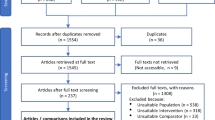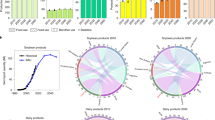Abstract
To achieve the United Nations Sustainable Development Goals related to food security and biodiversity, understanding their interrelationships is essential. By examining datasets comprising 189 food items across 157 countries during 2000–2018, we found that high-income countries exported more food to low-income countries than they imported. Many low-income countries, especially those with biodiversity hotspots, increasingly acted as net importers, suggesting that imports from high-income countries can benefit biodiversity in low-income countries. Because low-income countries without hotspots have rapidly raised their amounts of food exports to hotspot countries, such exports might help further reduce negative impacts on biodiversity. The increasing complexity of food trade among countries with and without biodiversity hotspots requires innovative approaches to minimize the negative impacts of global food production and trade on biodiversity in countries worldwide.
This is a preview of subscription content, access via your institution
Access options
Access Nature and 54 other Nature Portfolio journals
Get Nature+, our best-value online-access subscription
$29.99 / 30 days
cancel any time
Subscribe to this journal
Receive 12 digital issues and online access to articles
$119.00 per year
only $9.92 per issue
Buy this article
- Purchase on Springer Link
- Instant access to full article PDF
Prices may be subject to local taxes which are calculated during checkout




Similar content being viewed by others
Data availability
All data analysed during the current study are available from the corresponding author on reasonable request. The data that support the findings of this study are available within the paper, its Supplementary Information and Supplementary Data 1.
Code availability
The codes to perform our panel data analyses can be found at https://github.com/mingonchung/foodtrade-hotspot.
References
Sustainable Development Goals (United Nations, 2015); https://sustainabledevelopment.un.org
Nilsson, M., Griggs, D. & Visbeck, M. Policy: map the interactions between Sustainable Development Goals. Nature 534, 320–322 (2016).
Lu, Y., Nakicenovic, N., Visbeck, M. & Stevance, A.-S. Policy: five priorities for the UN Sustainable Development Goals. Nature 520, 432–433 (2015).
Xu, Z. et al. Impacts of international trade on global sustainable development. Nat. Sustain. https://doi.org/10.1038/s41893-020-0572-z (2020).
Xu, Z. et al. Assessing progress towards sustainable development over space and time. Nature 577, 74–78 (2020).
Liu, J. An integrated framework for achieving Sustainable Development Goals around the world. Ecol. Econ. Soc. 1, 11–17 (2018).
Zhao, Z. et al. Synergies and tradeoffs among Sustainable Development Goals across boundaries in a metacoupled world. Sci. Total Environ. https://doi.org/10.1016/j.scitotenv.2020.141749 (2020).
Liu, J. in The International Encyclopedia of Geography: People, the Earth, Environment, and Technology (eds Richardson, D. et al.) 1–8 (John Wiley & Sons, 2020).
Foley, J. A. et al. Solutions for a cultivated planet. Nature 478, 337–342 (2011).
Carole, D. & Ignacio, R.-I. Environmental impacts of food trade via resource use and greenhouse gas emissions. Environ. Res. Lett. 11, 035012 (2016).
Crist, E., Mora, C. & Engelman, R. The interaction of human population, food production, and biodiversity protection. Science 356, 260–264 (2017).
Wiedmann, T. & Lenzen, M. Environmental and social footprints of international trade. Nat. Geosci. 11, 314–321 (2018).
Delzeit, R., Zabel, F., Meyer, C. & Václavík, T. Addressing future trade-offs between biodiversity and cropland expansion to improve food security. Reg. Environ. Change 17, 1429–1441 (2017).
Marques, A. et al. Increasing impacts of land use on biodiversity and carbon sequestration driven by population and economic growth. Nat. Ecol. Evol. 3, 628–637 (2019).
Porkka, M., Kummu, M., Siebert, S. & Varis, O. From food insufficiency towards trade dependency: a historical analysis of global food availability. PLoS ONE 8, e82714 (2013).
Wood, S. A., Smith, M. R., Fanzo, J., Remans, R. & DeFries, R. S. Trade and the equitability of global food nutrient distribution. Nat. Sustain. 1, 34–37 (2018).
MacDonald, G. K. et al. Rethinking agricultural trade relationships in an era of globalization. Bioscience 65, 275–289 (2015).
Godfray, H. C. J. et al. Food security: the challenge of feeding 9 billion people. Science 327, 812–818 (2010).
DeFries, R. S., Rudel, T., Uriarte, M. & Hansen, M. Deforestation driven by urban population growth and agricultural trade in the twenty-first century. Nat. Geosci. 3, 178–181 (2010).
Moran, D. & Kanemoto, K. Identifying species threat hotspots from global supply chains. Nat. Ecol. Evol. 1, 0023 (2017).
Lenzen, M. et al. International trade drives biodiversity threats in developing nations. Nature 486, 109–112 (2012).
Dalin, C., Wada, Y., Kastner, T. & Puma, M. J. Groundwater depletion embedded in international food trade. Nature 543, 700–704 (2017).
Chaudhary, A. & Kastner, T. Land use biodiversity impacts embodied in international food trade. Glob. Environ. Change 38, 195–204 (2016).
Tilman, D. et al. Future threats to biodiversity and pathways to their prevention. Nature 546, 73–81 (2017).
Green, J. M. H. et al. Linking global drivers of agricultural trade to on-the-ground impacts on biodiversity. Proc. Natl Acad. Sci. USA https://doi.org/10.1073/pnas.1905618116 (2019).
Pimm, S. L. et al. The biodiversity of species and their rates of extinction, distribution, and protection. Science 344, 1246752 (2014).
Myers, N., Mittermeier, R. A., Mittermeier, C. G., da Fonseca, G. A. B. & Kent, J. Biodiversity hotspots for conservation priorities. Nature 403, 853–858 (2000).
Hoffman, M., Koenig, K., Bunting, G., Costanza, J. & Williams, K. J. Biodiversity hotspots (version 2016.1). Zenodo https://doi.org/10.5281/zenodo.3261807 (2016).
World Development Indicators (World Bank, 2020); https://data.worldbank.org
Liu, J. et al. Framing sustainability in a telecoupled world. Ecol. Soc. 18, 26 (2013).
Hull, V. & Liu, J. Telecoupling: a new frontier for global sustainability. Ecol. Soc. https://doi.org/10.5751/ES-10494-230441 (2018).
Kapsar, K. E. et al. Telecoupling research: the first five years. Sustainability 11, 1033 (2019).
Richards, D. R. & Friess, D. A. Rates and drivers of mangrove deforestation in Southeast Asia, 2000–2012. Proc. Natl Acad. Sci. USA 113, 344–349 (2016).
Chung, M. G., Kapsar, K., Frank, K. A. & Liu, J. The spatial and temporal dynamics of global meat trade networks. Sci. Rep. 10, 16657 (2020).
Soterroni, A. C. et al. Expanding the soy moratorium to Brazil’s Cerrado. Sci. Adv. 5, eaav7336 (2019).
Phalan, B., Onial, M., Balmford, A. & Green, R. E. Reconciling food production and biodiversity conservation: land sharing and land sparing compared. Science 333, 1289–1291 (2011).
Bardgett, R. D. et al. Combatting global grassland degradation. Nat. Rev. Earth Environ. 2, 720–735 (2021).
Dengler, J., Janišová, M., Török, P. & Wellstein, C. Biodiversity of Palaearctic grasslands: a synthesis. Agric. Ecosyst. Environ. 182, 1–14 (2014).
Wimberly, M. C., Narem, D. M., Bauman, P. J., Carlson, B. T. & Ahlering, M. A. Grassland connectivity in fragmented agricultural landscapes of the north-central United States. Biol. Conserv. 217, 121–130 (2018).
Wu, W. et al. Global cropping intensity gaps: increasing food production without cropland expansion. Land Use Policy 76, 515–525 (2018).
Dou, Y., da Silva, R. F. B., Yang, H. & Liu, J. Spillover effect offsets the conservation effort in the Amazon. J. Geogr. Sci. 28, 1715–1732 (2018).
Sun, J. et al. Importing food damages domestic environment: evidence from global soybean trade. Proc. Natl Acad. Sci. USA https://doi.org/10.1073/pnas.1718153115 (2018).
Liu, J. et al. Spillover systems in a telecoupled Anthropocene: typology, methods, and governance for global sustainability. Curr. Opin. Environ. Sustain. 33, 58–69 (2018).
Díaz, S. et al. Pervasive human-driven decline of life on Earth points to the need for transformative change. Science 366, eaax3100 (2019).
Post-2020 Global Biodiversity Framework: Discussion Paper Adopted by the Conference of the Parties CBD/POST2020/PREP/1/1 (UNEP, 2019); https://www.cbd.int/doc/c/d0f3/aca0/d42fa469029f5a4d69f4da8e/post2020-prep-01-01-en.pdf
Ehrlich, P. R. & Harte, J. Food security requires a new revolution. Int. J. Environ. Stud. 72, 908–920 (2015).
Redford, K. H. et al. Mainstreaming biodiversity: conservation for the twenty-first century. Front. Ecol. Evol. 3, 137 (2015).
Pe’er, G. et al. EU agricultural reform fails on biodiversity. Science 344, 1090–1092 (2014).
Liu, J. Consumption Patterns and Biodiversity (Biodiversity Programme of the Royal Society, 2020); https://royalsociety.org/topics-policy/projects/biodiversity/consumption-patterns-and-biodiversity
Liu, J., Daily, G. C., Ehrlich, P. R. & Luck, G. W. Effects of household dynamics on resource consumption and biodiversity. Nature 421, 530–533 (2003).
World Population Prospects (United Nations Department of Economic and Social Affairs Population Division, 2019); https://population.un.org/wpp/Download/Standard/Population/
FAOSTAT Statistics Database (UN FAO, 2020); https://www.fao.org/faostat
R Core Team. R: A Language and Environment for Statistical Computing (R Foundation for Statistical Computing, 2021); https://www.r-project.org
Kastner, T., Kastner, M. & Nonhebel, S. Tracing distant environmental impacts of agricultural products from a consumer perspective. Ecol. Econ. 70, 1032–1040 (2011).
Liu, J. Forest sustainability in China and implications for a telecoupled world. Asia Pac. Policy Stud. 1, 230–250 (2014).
Torres-Reyna, O. Getting Started in Fixed/Random Effects Models Using R (Data & Statistical Services, Princeton Univ., 2010).
Chung, M. G., Dietz, T. & Liu, J. Global relationships between biodiversity and nature-based tourism in protected areas. Ecosyst. Serv. 34, 11–23 (2018).
O’Brien, R. A caution regarding rules of thumb for variance inflation factors. Qual. Quant. 41, 673–690 (2007).
Acknowledgements
We thank S. Nichols for helpful comments on earlier drafts, as well as the organizations that provided the data for this study. Funding was provided by the US National Science Foundation (grant no. 1924111, J.L.), Michigan AgBioResearch (J.L.) and the Sustainable Michigan Endowment Project (M.G.C.).
Author information
Authors and Affiliations
Contributions
M.G.C. analysed the model and drafted the manuscript. M.G.C. and J.L. conceived of the study, revised the manuscript and reviewed the manuscript.
Corresponding author
Ethics declarations
Competing interests
The authors declare no competing interests.
Peer review
Peer review information
Nature Food thanks Kamal Bawa, Stuart Pimm and Cibele Queiroz for their contribution to the peer review of this work.
Additional information
Publisher’s note Springer Nature remains neutral with regard to jurisdictional claims in published maps and institutional affiliations.
Extended data
Extended Data Fig. 2 Average annual food flows (Mt/year) from 2000 to 2018. Food flows between high-hotspot countries (HHC), low-hotspot countries (LHC), and non-hotspot countries (NHC) with high- and low-income.
Non-hotspot countries are marked by red, high-hotspot countries by dark green, and low-hotspot countries by light green. The arc length of an outer circle indicates the sum of food exported and imported in each group. The arc length of a middle circle refers to the quantity of food exports. The inner arc length shows the quantity of food imports. Raw data from UN FAO52.
Extended Data Fig. 3 Spatial distribution of per capita crop production (kg/capita) and per capita harvested areas (m2/capita) in 2010.
(a) county-level of crop production, (b) hotspot-level of crop production, (c) county-level of harvested area, and (d) hotspot-level of harvested area.
Extended Data Fig. 5 Quantity of net food trade between high-hotspot countries (HHC), low-hotspot countries (LHC), and non-hotspot countries (NHC) with high and low income.
The group of high-, low-, and non-hotspot countries were classified with the proportion of biodiversity hotspots in harvested areas: (a) Blue indicates net food trade (export–import) in 2000, red indicates net food trade in 2018, and cyan indicates average net annual food trade from 2000–2018. The net amounts of food trade in each group are not linearly increased or decreased over time. The net amounts of food trade in 2000 and 2018 can be lower or higher than those in other mid-years. (b) The amounts of net food trade between high-income and low-income countries in high-hotspot countries (HHC), low-hotspot countries (LHC), and non-hotspot countries (NHC) from 2000–2018. Non-hotspot countries are indicated by red, high-hotspot countries by dark green, and low-hotspot countries by light green.
Supplementary information
Supplementary Information
Supplementary Tables 1–8 and methods.
Supplementary Data 1
Food trade, land savings and subnational analyses from 2000 to 2018.
Rights and permissions
About this article
Cite this article
Chung, M.G., Liu, J. International food trade benefits biodiversity and food security in low-income countries. Nat Food 3, 349–355 (2022). https://doi.org/10.1038/s43016-022-00499-7
Received:
Accepted:
Published:
Issue Date:
DOI: https://doi.org/10.1038/s43016-022-00499-7
This article is cited by
-
Telecoupled impacts of the Russia–Ukraine war on global cropland expansion and biodiversity
Nature Sustainability (2024)
-
Effects of global shocks on the evolution of an interconnected world
Ambio (2023)
-
Freshwater species diversity loss embodied in interprovincial hydroelectricity transmission with ecological network analysis
Environmental Science and Pollution Research (2023)
-
We can have biodiversity and eat too
Nature Food (2022)



